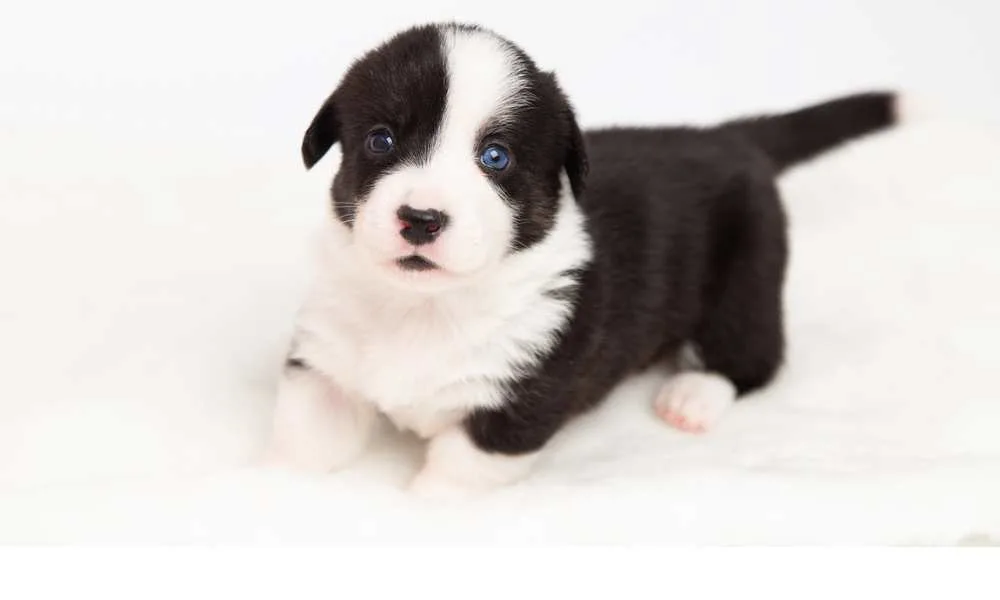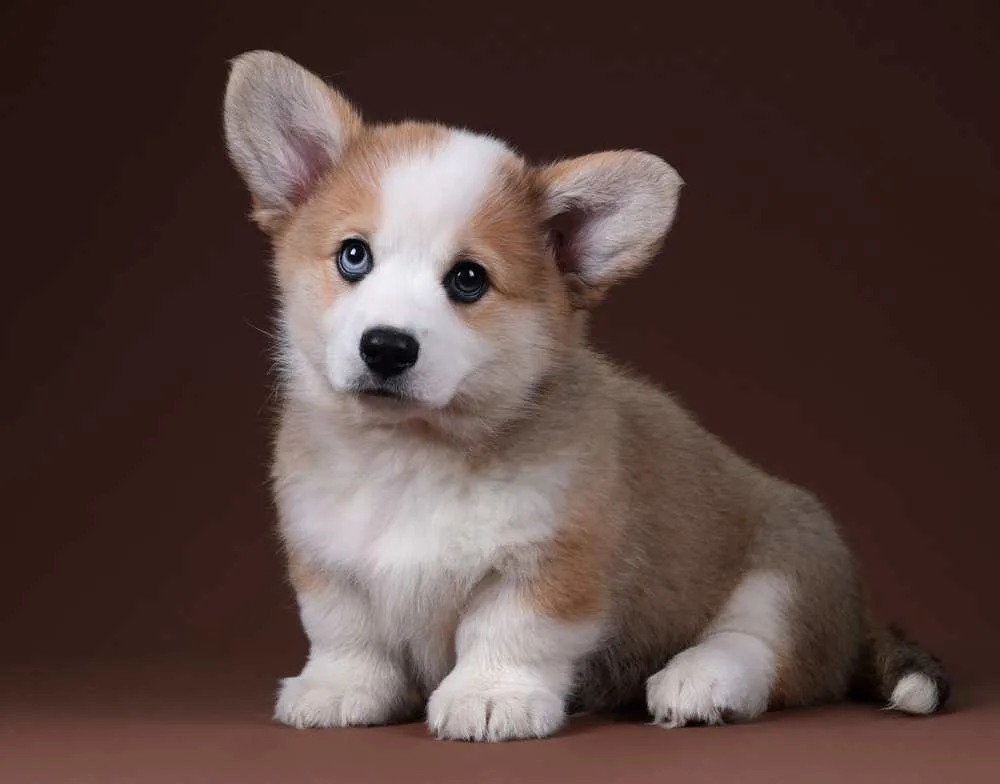Are blue eyes in Corgis a fault or not?
We will help you find the answer to this question by revealing the breed standard for the eye color of both Pembroke Welsh Corgis and Cardigan Welsh Corgis.
Do Corgis ever have blue eyes?
Yes, and they look super-cute when they do. We know that you will love your Corgi no matter what color of his or her eyes is, but if you are interested in learning whether your pup meets all the KC/FCI or AKC standards, the following text will be of great help.
We have some excellent advice for blue-eyed Corgi owners too. So, stay tuned; we will get down to business right away!

Can Corgis Have Blue Eyes?
Most puppies and kittens are born with blue eyes that usually go to a grey or brown shade as they get older. The same goes for Corgis.
If your Corgi is born with blue eyes, it does not mean that they will stay that way. Quite the opposite, blue eyes in Corgis are the result of a rare genetic mutation. Therefore, Corgis with one or two blue eyes are not a common thing.

The most important thing to remember for all the true Corgi breed lovers is that, except for the eye-color, dogs with blue eyes are not physically different from their brown-eyed relatives. The quality of these dogs is not compromised. They are perfectly healthy and will make any owner happy.
Unfortunately, according to the standard, having blue eyes is considered a fault. It goes for both Cardigan Welsh Corgis and Pembroke Welsh Corgis. The blue merles are the only exception- all other Corgis with blue eyes or one blue and one dark eye will be disqualified.
If you want to know more about these standards or how and why blue eyes occur in Corgis, stay tuned. We have covered all the details.

KC/FCI and AKC Standards for the Eye Color in Corgis
It goes without saying that your Corgi is the most precious Corgi in the world – for you and your family. However, there are strict standards prescribed for each breed that determine whether or not a dog can have any success at dog shows. If you want your pup to have a bright future at such events, the color of your Corgi’s eyes can be of great importance.
Read the following two paragraphs to find out whether your Corgi meets the required standards:
The Breed Standard For The Eye Color Of The Cardigan Welsh Corgi
According to the KC/FCI standard, a Cardigan Welsh Corgi should have dark eye color to blend with its coat. Blue, pale blue, or blue flecked eyes are permitted only if you have a blue merle Corgi.
The AKC standard is no different. It states that Cardigan Corgi’s eyes should be dark, clear, and in tune with its coat color. Blue eyes or partially blue eyes are permitted only for blue merles. Blue merle Cardigans can have two blue eyes, one brown and one blue flecked eye, or one blue and one completely brown eye.
The Breed Standard For The Eye Color Of The Pembroke Welsh Corgis
According to the KC/FCI standard, a Pembroke Welsh Corgi should have brown eyes that blend with its natural color of the coat.
The AKC allows for the variations of brown as long as they are in harmony with coat color. Bluish eyes are not allowed, and neither are the yellow or true black eyes.
What Are “Wall Eyes”?
When it comes to Pembroke Corgis, it sometimes happens that tricolor puppies (red, sable, or brindle) have one or two blue eyes – they are called “wall eyes”.
“Wall eyes” do not necessarily mean that your Corgi carries a merle gene. Such eyes can be a result of a different mode of inheritance. As far as genetics is concerned, such eyes are the same type of blue eye found in breeds such as Siberian Husky.
The Pembroke Welsh Corgis have this type of blue eyes quite rarely, though. The research has shown that such eyes occur in only one of sixteen puppies with parents who both carry the recessive genes for this blue eye. It depends on the so-called polygenic mode of inheritance, while the merle gene is autosomal dominant and is thus inherited in an entirely different manner.

The Genetics Behind The Blue Eyes In Corgis
As far as the Oxford dictionary of English language is concerned, Genetics is a study of heredity and the variation of inherited characteristics. It is quite a complex science, but we will still try to explain how it influences the occurrence of blue eyes in Corgis.
For starters, you need to know that the blue eye in Corgis appears only if there is more than one pair of recessive genes in a homozygous state. There are various possible combinations of two pairs of genes in the mating of Corgis that are heterozygous for both genes. These genes are labeled Aa and Bb – the capital letters stand for the dominant gene for dark eyes, while the lower-case letters represent the recessive gene for the blue eyes.
In order to have at least one blue eye, your puppy needs to have four genes for recessive quality. The research has not yet been completed, so the number of genes required for a blue eye to occur is still theoretical. However, it is certain that at least two pairs are needed. The following table will help you understand all this much better.
- Sire (AaBb) x Dam (AaBb)
- A and B – the presence of either of these genes assures brown eyes.
- a and b – four of these genes are necessary to produce a blue eye.
| AB | Ab | aB | ab | |
|---|---|---|---|---|
| AB | 1 AABB | 2 AABb | 3 AaBB | 4 AaBb |
| Ab | 5 AABb | 6 AAbb | 7 AaBb | 8 Aabb |
| aB | 9 AaBB | 10 AaBb | 11 aaBB | 12 aaBb |
| ab | 13 AaBb | 14 Aabb | 15 aaBb | 16 aabb |
As you can see, there is only one combination out of sixteen presented in this table that is homozygous (pure) for the dominant quality (AABB). It means that such a pair of Corgis can’t produce or pass on genes for anything but a brown-eyed puppy.
Likewise, there is only one option that is homozygous (pure) for the recessive quality (aabb). Only this combination will give you a blue-eyed puppy. Therefore, the possibility that this particular pair will come up is very slim. It occurs in only one out of sixteen puppies.
The table shows all the other possible combinations of these two pairs of genes as well. It explains why we cannot claim that a particular dog is free of the recessives by observing only the breeding results in a single generation. That is possible only for a simple recessive.
What does this mean?
If you have a Corgi that is AAbb and pair it with another dominant, there is no chance that you will get a blue-eyed puppy. However, the recessives for this quality are passed on, and, therefore, there is a possibility that blue eyes will occur in the next generation.

As you can see, you can never be 100% sure if the puppy you are adopting carries the gene for unwanted blue eyes. Even if its predecessors never produced blue eyes before, it is almost impossible to guarantee that your pup does not carry genes for this quality. It can pop up when you least expect it!
Therefore, if you are a breeder, you should take a deep breath and relax. Do not waste your time and energy trying to secure those qualities that are not detrimental to the dogs’ health. The formula for successful Corgi breeding is in the careful selection of your breeding stock – and by that, we mean choosing healthy dogs! Everything else is pure cosmetics!

How To Take A Good Photo Of A Blue-eyed Corgi?
Perhaps your blue-eyed Corgi will not get the grand trophy at any AKC dog show, but that does not mean that you should not take great-looking photos of your pooch and post them online for all your friends to see. Blue eyes are a rare thing when it comes to Corgis, and your photos will surely stand out and earn a lot of likes.
The problem is that, unlike Corgis with brown eyes that appear either green or yellowish when photographed with the flashlight, the eyes of Corgis with blue eyes reflect red. It is all thanks to a so-called tapetum lucidum, an iridescent layer that can be found behind all dogs and cats’ retina. It acts like a mirror and reflects the light. It is also a reason why your pet’s eyes shine when you point any light source towards them in the dark.
The role of tapetum lucidum is to improve vision in low-light conditions. People do not have this layer, and that is why dogs and cats can see better in the dark.
Let’s get back to the red reflection that causes problems in your Corgi’s photos. Why does it occur?
Dogs with blue eyes lack either pigmentation or tapetum lucidum, and, as a result, their choroidea shines through and creates the red-eye effect in photos. The same happens with human eyes since we do not have a tapetum lucidum either. As you can see, the red-eye effect has nothing to do with the color of the eyes.
Even if your blue merle Corgi has one blue and one brown eye, both eyes will reflect red in the photos. If a Corgi does not carry a blue merle gene, their brown eye will not reflect red, but the blue one will – that brings us to a crucial question…

How Come All Blue Merle Corgis Do Not Have A Tapetum Lucidum?
The merle gene (M) is responsible for pigmentation, but it also hinders the development of the tapetum or its function. Some dogs lack the tapetum lucidum altogether. Luckily for all blue-eyed Corgi lovers, it does not seem that dogs without this layer have worse night-vision compared to their brown-eyed relatives.
There is not much that you can do to avoid the red effect when you are obliged to use the flash. The only advice we can give you is to avoid using it whenever possible. In this way, your Corgi’s blue eyes will show in every picture you take.

Final Words
If you ever wondered do Corgis have blue eyes; you now know that they do. Blue-eyed Corgis are often not in tune with the breed standard, but it does not mean that they are not just as good and worthy of your love as their brown-eyed relatives. Love your dog and take good care of him or her – no matter what color of his or her eyes is!

